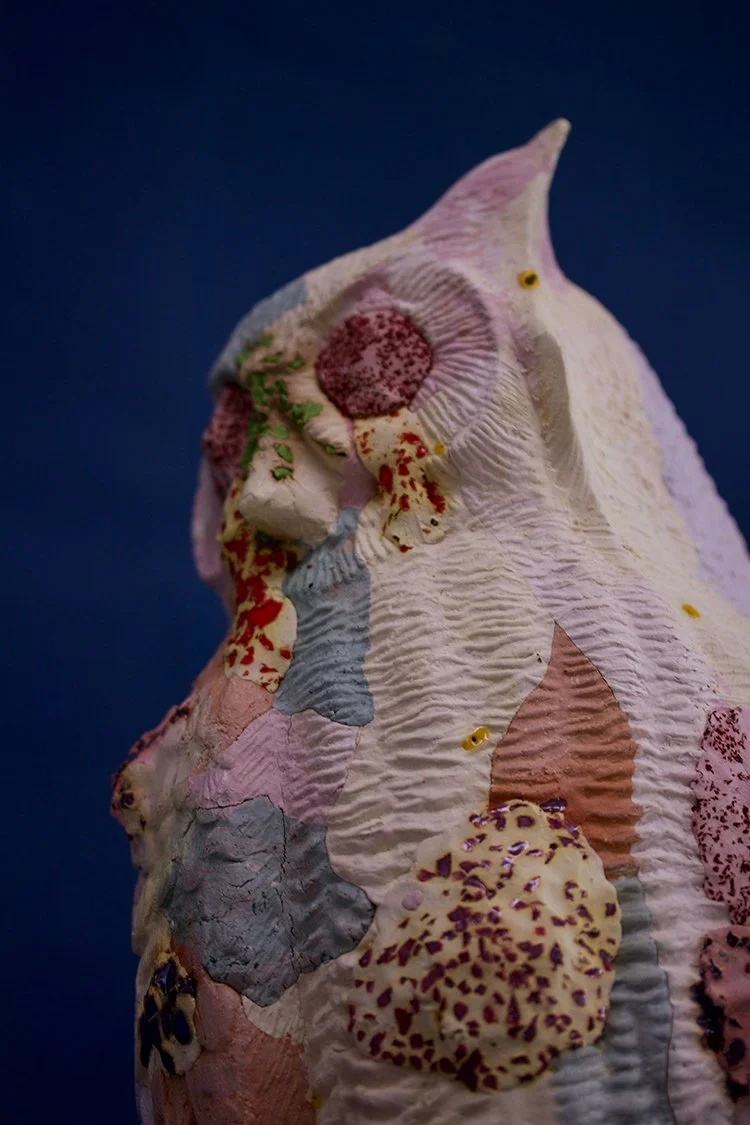In Flux
The Crystal Chain Gang, In Flux (detail), 2020. Porcelain, slip glass. Image courtesy of the artists.
When I think of a chandelier, I envisage elegant glass beads cascading down a frame of concentric loops, glistening high above the heads of the rich and famous as they sip champagne in a grand European hall.
The Crystal Chain Gang have had a long interest in disrupting our expectations of these lavish objects, building chandeliers with pendants that mimic chicken feet and budgie carcasses, cast in saturated colour. Equal parts repellent, gaudy and alluring, their work ridicules excess. Their media is a fitting choice for their message: glass production is an expensive enterprise and for centuries it has been tied up with money, not only in the extravagance associated with fine objects but in the commercialisation of everyday items like lightbulbs and jars.
Today most glass products are made in China, but the industrialisation of glass began on the island of Murano, just off the coast of Venice. Over its history Murano has housed up to 500 studios at a time, which have specialised in functional and decorative glassware. Last September, eager to push the boundaries of their practice and connect with others in this glass mecca, The Crystal Chain Gang set off to Venice on a research trip. While there, they attended renowned exhibitions, visited specialist libraries and met with Studio Berengo, who arrange collaborations between highly skilled glass masters and world-renowned artists. In Flux springboards off the work of dynasty families that have been producing their signature pieces for hundreds of years. The artists reflect that:
Blown glass chandeliers have been made on the island of Murano since the seventeenth century. In the twenty-first century, they are a thriving component of local high-end exports, while also representing the Old World. Chandelier makers are traditionalists who resist experimentation, yet these large-scale objects have remained in production through centuries of change: bearing witness to revolutions and upheavals…
A few months after their return, the World Health Organisation declared a global pandemic. The Crystal Chain Gang went into lockdown wondering how to make sense of this new state of disorder and like many of us, they began to change the way they worked. Instead of the brightly coloured cast glass works they are known for, the artists opted for pastel, hand-blown pieces. Blown glass is synonymous with Murano, but the artists also used a technique developed there called frit overlay, which creates the speckled effect on the surface of each form. This patterning is made by applying crushed coloured glass over the ‘gob’ of molten glass as it comes out of the furnace, is rolled on a bench, blown and formed. Today in Venice frit overlay is a commonplace method generally used to make kitsch souvenirs as opposed to expensive chandeliers.
The patterning and shape of the glass forms give them an organic quality. Pulsating with life, they sit precariously on branches of richly textured ceramic tubes. Experimenting in melding media, the Crystal Chain Gang have made these cylindrical components by firing stoneware clay imbedded with tiny shards of glass and occasional slathers of glazed porcelain. They are fragile and roughly hewn, with uneven surfaces that appear as if afflicted with an unidentified condition. Also perched on the chandelier is a large ceramic barn owl, one of the most widely distributed species of owl on the planet. Like the majority of birds used by the Crystal Chain Gang, barn owls were introduced to Aotearoa New Zealand, bringing to mind historically imported diseases like measles and the Spanish flu.
This chandelier looks more like a viral cell than an ornate lighting fixture, and its elements signify the artists’ concern about the uneasy tension between the world economy and public health. Visiting the Crystal Chain Gang’s studio while In Flux was being made, they explained to me that their chosen title is not only about being in a state of uncertainty, but is also a technical term, referring to a substance used in the process of vitrifying glass and ceramics. Conflating Old World techniques with the tourist market of Venice and flagrantly adding ceramics, their practice challenges both the tradition of glassmaking and the commercial world that sustains it, becoming a metaphor for what happens when excess goes wrong. Made with playful disdain, In Flux is a chandelier that bears witness to our current times and asks us to look at the past through a critical lens as we navigate the new normal.
***
This text was originally written for a publication in 2020 accompanying the exhibition The Crystal Chain Gang: In Flux at Aratoi—Wairarapa Museum of Art and History.
***

